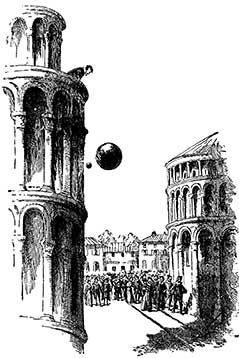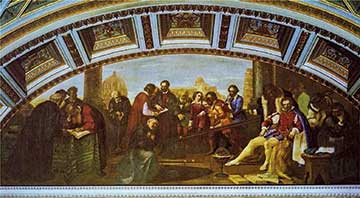 Legend has it that Galileo Galilei dropped two weights from the Leaning Tower of Pisa to prove that objects of different weights fall at the same rate. Historians doubt this claim. They are also sceptical about Galileo’s description in his masterpiece Discourses Concerning Two New Sciences, of an experiment of rolling a 100-pound cannon ball and a 1-pound musket ball down an incline to study their acceleration using a water clock. “Too much accumulation of sources of error and inexactitude!” they exclaimed. Be that as it may, there is no denying that Galileo had dared debunk Aristotle’s theory which had been held sacrosanct for centuries. Aristotle, in the 4th Century BC, articulated that an object falls in proportion to its weight. A feather will take much longer to reach the ground than a rock. This erroneous assumption held ground for centuries because it tallies with our everyday experience. But Galileo had the wit to ask himself, “What if I tie the lighter object to the heavier object? Will the combined mass fall faster than the individual objects or will it fall at an average rate?”
Legend has it that Galileo Galilei dropped two weights from the Leaning Tower of Pisa to prove that objects of different weights fall at the same rate. Historians doubt this claim. They are also sceptical about Galileo’s description in his masterpiece Discourses Concerning Two New Sciences, of an experiment of rolling a 100-pound cannon ball and a 1-pound musket ball down an incline to study their acceleration using a water clock. “Too much accumulation of sources of error and inexactitude!” they exclaimed. Be that as it may, there is no denying that Galileo had dared debunk Aristotle’s theory which had been held sacrosanct for centuries. Aristotle, in the 4th Century BC, articulated that an object falls in proportion to its weight. A feather will take much longer to reach the ground than a rock. This erroneous assumption held ground for centuries because it tallies with our everyday experience. But Galileo had the wit to ask himself, “What if I tie the lighter object to the heavier object? Will the combined mass fall faster than the individual objects or will it fall at an average rate?”
Thus the mind of the Father of modern science started working and he set out to deduce the law of falling objects mathematically as well as observe them experimentally. It was not just about who reaches the ground faster, it was also about the rate of fall – the acceleration. In 1604, Galileo did not have the advantage of time lapse photography or electronic sensors. So he had to slow down the fall using an inclined plane. Stillman Drake, a leading expert on Galilean science, accessed at the Biblioteca Nazionale Centrale in Florence, the manuscripts and scribbles left behind by Galileo and discovered some early papers that appeared to be some experiment conducted in 1604 in Padua. From the jottings, Drake recreated the following experiment:
Galileo released a ball at the top of a wooden incline, noting, in the first few moments that it travelled a distance of 33 punti (points). After an equal amount of time had passed, the ball picked up speed and covered a distance of 130 punti and by the end of the third interval, 298 punti, then 526, 824, 1192, 1620. For the final distance, when the ball would have been moving at top speed, Galileo had actually written 2123 punti. Then he scratched it out and corrected it to 2104. Beside some of his figures he put a plus or minus sign, apparently indicating when his measurements seemed high or low.
| 1 | 2 | 3 | 4 | 5 | 6 | 7 | 8 | ticks |
| 33 | 130 | 298 | 526 | 824 | 1192 | 1620 | 2104 | Punti |
At first no pattern leaps forth. With each tick the ball covers more ground. But by what rule? What if you divide 130 by 33? 130/33 = 3.9. The distance had increased by almost 4 times. With the third tick, the increase was 298/33, slightly more than 9 times the initial distance. Then 15.9, 25.0, 36.1, 49.1, 63.8. He rounded the numbers and wrote them using a different ink and pen: 4, 9, 16, 25, 36, 49, 64. He had found the key: allowing for a bit of error, the distance covered increased with the square of time.
 That Galileo’s numbers were not exact, testified to the reality of the experiment. That they were as close as they were, testified to his skill as an experimenter.
That Galileo’s numbers were not exact, testified to the reality of the experiment. That they were as close as they were, testified to his skill as an experimenter.
There was still the question of how Galileo arrived at such precise timing, working with intervals of less than a second. Chronometers had not been invented yet. Stillman Drake has suggested that Galileo used a musical method for keeping time. Galileo did not have to measure time in seconds and half seconds. He just needed to divide time in equal portions. This is a talent that comes naturally to any good musician. Drake speculates that before the ball rolled down the incline, Galileo established a rhythm by singing a simple tune. After several attempts he would have marked off the track in approximately half second intervals, noting that the space became progressively greater. The next step was to tie a piece of catgut at each chalk mark, like the movable frets on the neck of a lute. Rolling the ball again and again, he listened as it struck the frets, adjusting their positions till the rhythm of the clicking was as uniform as a metronome’s. When he was done, the frets showed precisely how far the ball had travelled during equal intervals of time. All that was left was to measure the spacing with a ruler.
 Once Galileo had established his law, Drake believed he showed it to others in an easier, less precise manner by marking the track beforehand – 1, 4, 9, 16, 25, 36, 49, 64 … and then using a water clock to confirm the timing. But that was a demonstration, not an experiment.
Once Galileo had established his law, Drake believed he showed it to others in an easier, less precise manner by marking the track beforehand – 1, 4, 9, 16, 25, 36, 49, 64 … and then using a water clock to confirm the timing. But that was a demonstration, not an experiment.
Why didn’t he write about his original method? The best Drake could suggest is that Galileo was afraid of sounding silly. Even in his day it would have been foolish to write “I tested this law by singing a song while a ball was rolling down a plane, and it proved quite exact.”
Today, the law can be accurately tested by placing 10 low power laser beams horizontally across the path of vertical fall of an object and positioning LDRs (light – dependent resistors) triggering electronic clocks at the other end of the laser beams. The law can also be proved by doing time lapse photography of a falling object. The camera can be programmed to take an image after a millisecond or so and the images placed side by side to chart the acceleration of the object.
Incidentally, the experiment with a feather and a rock was conducted on the Moon. Since the moon has no atmosphere, the free fall of the two objects was not disturbed by buoyant force or air drag. The feather and the rock landed simultaneously on the surface of the moon. Something similar can be demonstrated very easily in a classroom using a book and a two rupee or a ten rupee coin and a slightly smaller paper coin.
Galileo’s genius lay in refuting a time honoured belief by asking the right question and then designing a fool proof experiment to prove his point. Galileo had studied falling objects in his early career, before he turned his attention to celestial objects. He was to refute other time-honoured beliefs before he was kept under house arrest by an irate pope.
Reference
George Johnson, The Ten Most Beautiful Experiments, The Bodley Head, London.
Galileo Galilei
